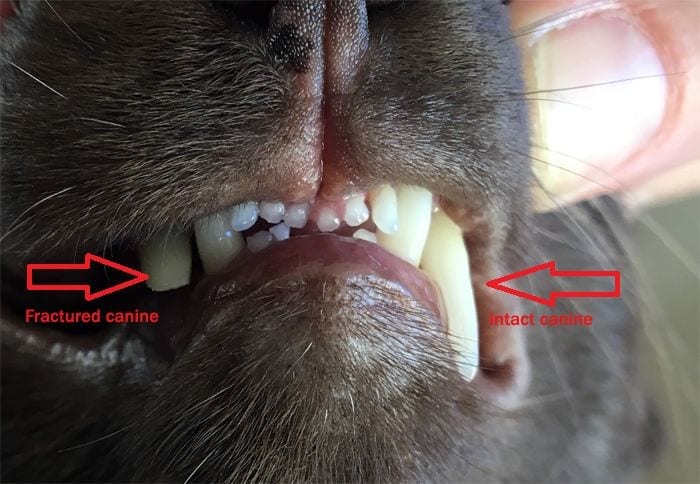Dental fractures are a break in the hard outer layer of the teeth (enamel), which can penetrate through to the underlying tissue or roots. The most common causes are chewing on hard objects such as cooked bones, falls, blunt force trauma (such as a kick to the face) and motor vehicle accidents can also lead to dental fractures.
The canine (fang) teeth are the most commonly affected followed by the incisors.
The teeth consist of several layers:
- Enamel: The hard outer layer of the teeth above the gum line (crown). Enamel is the hardest tissue in the mammalian body.
- Dentin: Below the tough exterior, dentin is hard dense bony tissue that forms the bulk of a tooth. Dentin is arranged as a collection of tubules that run from the pulp towards the enamel.
- Pulp: The innermost portion of the tooth. Pulp consists of connective tissue, nerves and a rich supply of blood vessels.
Types of dental fracture
Dental fractures can be uncomplicated or complicated, the type of dental fracture will determine the treatment options.
Uncomplicated dental fractures affect only the outer enamel and dentin layers and top portion of the teeth (crown) and the root which is located beneath the gum line.
- Enamel infraction – Microcracks within the dental enamel of the tooth
- Enamel fracture – A complete fracture of the crown with a loss of crown substances, no involvement of the dentine or pulp
- Uncomplicated crown fracture – A fracture of the crown and dentine, but with no exposure of the pulp
Complicated dental fractures involve the enamel, dentin and inner portion of the tooth (pulp). The pulp responds to trauma by inflammation (pulpitis), which can spread up or down the pulp. Left untreated, bacteria can invade the pulp and roots, leading to irreversible damage.
- Enamel-dentine fracture involving pulp exposure, which has a pinkish hue
- Root fracture with or without crown loss
Symptoms
- Missing a part of a tooth
- A visible crack in the tooth or a missing portion of the tooth (as in the photo above)
- Discolouration of the tooth
- Difficulty or reluctance to eat or showing a preference for eating on one side
- Drooling
- Pain
- Withdrawal
- Weight loss
- Facial swelling if a dental abscess has developed
Symptoms can vary depending on the severity of the fracture and often a cat with an uncomplicated fracture has symptoms at all.
Diagnosis
Early diagnosis is important, dental pain can be incredibly painful to the cat, and the longer the tooth remains untreated, the greater the risk to the underlying tissue.
The veterinarian will perform a complete physical examination of the cat which will include a thorough oral examination.
Dental x-rays will be necessary to assess the alveolar bone, root, pulp chamber space, periodontal ligament space, and root canal space.
Treatment
Treatment will depend on the type of fracture, and the amount of time that has passed since the injury. All procedures require general anesthesia. The veterinarian may recommend baseline tests to evaluate the overall health of the cat prior to surgery.
Uncomplicated fractures involving the enamel only will need to be smoothed over to prevent damage to the surrounding soft tissue with a diamond burr or polishing disks to remove any jagged edges.
Uncomplicated fractures which involve the enamel and underlying dentin will need bonded composite restoration to prevent tooth sensitivity or invasion of bacteria through the dentin tubules and into the pulp and restore the tooth with layers of bonded dental sealants and composites.
Complicated fractures with pulp exposure require immediate care. If less than 24-48 hours have elapsed, or the cat is under 12-18 months, the veterinarian may be able to perform a vital pulpotomy and pulp capping. The diseased pulp is in the crown is removed and the remaining healthy pulp capped with a biocompatible material which stimulates the formation of dentin over the area.
Unless treated within 24-48 hours, fractures that expose the pulp generally have two treatment options, root canal therapy or extraction.
Root canal therapy (also called endodontic treatment) involves extracting pulp and diseased dentin, followed by cleaning and sealing the canal with a rubber sealant called gutta percha. Where necessary, aesthetic crowns (porcelain or ceramic) are placed over the crown to protect it. Root canal therapy is less invasive than extraction and the cat keeps the damaged tooth.
It is always preferable to save teeth, however often the only solution is to surgically extract the tooth and roots.
Cats who have had dental restoration work will need annual x-rays, under anesthesia to monitor their teeth.
Can I just leave the fractured tooth as is?
No, a fractured tooth is extremely painful but pulpitis will eventually lead to a dental abscess, oronasal fistulas and infection of the surrounding bone.

